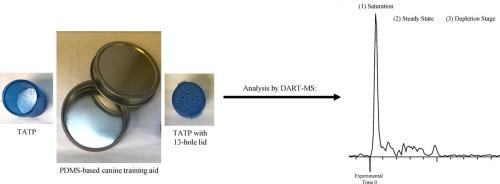Forensic Chemistry ( IF 2.6 ) Pub Date : 2021-02-13 , DOI: 10.1016/j.forc.2021.100315 Alison G. Simon , Kelly Van Arsdale , Jason Barrow , Jarrad Wagner

|
Direct analysis in real time-mass spectrometry (DART-MS) was used to explore the behavior of vapor released from triacetone triperoxide (TATP) versus an absorption-based canine training aid sometimes called a polydimethylsiloxane (PDMS) polymer odor capture and release (POCR) system. The results compare dissipation from the source to the instrument (in minutes), steady state signal intensity (i.e. approximate relative amounts), and dissipation of the odor after removing the source (also in minutes). Several parameters were tested: reproducibility between POCRs, TATP versus TATP with a lid (containing 13 drilled holes), distance from the detector, heights of the source, concealment, purposeful air disturbances, blanks, and containment systems.
In general, the PDMS-based training aid behaved similarly to the TATP with a 13-hole lid, which is the aid most often used by the FBI’s National Canine Improvised Explosives Detection Program. Results shows that the PDMS-based training aids are reproducible and reliable at steady state as a vapor release system. As expected, signal was decreased given increased distance from the DART interface for all sample types, when using the odor-restricting lid with the 1 g TATP sample, when all samples were placed at height, and when using a cotton bag as a method of concealment. Despite having no direct correlation, these results support anecdotal canine evidence since canine handlers tend to report that their dogs have more difficulty finding training aids within those same parameters. Further, adding purposeful air disturbances had a larger effect on signal intensity for 1 g TATP than on the PDMS-based training aid. Finally, adding a masking odor at the DART interface decreased detection of TATP regardless of the vapor source, but did not fully diminish it. This too agrees with canine handler reports and previous research, where dogs may have a more difficult time locating odors in the presence of high background.
This is the first report of its kind to use real-time detection to characterize vapor release and dissipation from a biosensor training aid in comparison to the corresponding true material it intends to replace. By using the three phases of odor release (saturation, steady state, and depletion), the study investigates the effects of several ambient parameters on TATP volatile detection from true material and the PDMS-based training aid.
中文翻译:

使用DART-MS实时监控基于PDMS的犬训练辅助设备释放的TATP和批量TATP
实时质谱法(DART-MS)中的直接分析用于探索从三丙酮三氧化过氧化物(TATP)释放的蒸汽与有时称为聚二甲基硅氧烷(PDMS)的基于吸收的犬训练助剂的聚合物气味捕获和释放(POCR)的行为) 系统。结果比较了从源到仪器的耗散(以分钟为单位),稳态信号强度(即,大约相对量)和在移除源后气味的耗散(也以分钟为单位)。测试了几个参数:POCR之间的可重复性,带盖的TATP与TATP(包含13个钻孔),距检测器的距离,源高度,隐蔽性,有意的空气干扰,空白和密闭系统。
通常,基于PDMS的训练辅助工具的行为类似于带有13孔盖的TATP,这是FBI的国家犬类简易爆炸物检测程序最常使用的辅助工具。结果表明,基于PDMS的培训辅助工具可在稳定状态下作为蒸汽释放系统重现并可靠。不出所料,当使用气味限制盖和1 g TATP样品,将所有样品放在高处以及使用棉布袋作为方法时,对于所有类型的样品,距DART界面的距离均增加,信号降低。隐藏。尽管没有直接相关性,但这些结果支持了轶事犬类证据,因为犬只管理人员倾向于报告说,它们的狗在相同参数范围内寻找训练辅助装置更加困难。进一步,与基于PDMS的训练辅助相比,添加有目的的空气干扰对1 g TATP的信号强度影响更大。最后,在DART界面处添加掩盖气味会降低TATP的检测率,而与蒸气源无关,但并不能完全消除它。这也与犬类处理者的报告和先前的研究相吻合,在这种情况下,在高背景下,狗可能很难定位气味。
这是同类报告中首次使用实时检测来表征生物传感器训练辅助设备中与拟替代的相应真实材料相比的蒸气释放和消散的报告。通过使用气味释放的三个阶段(饱和,稳态和耗竭),该研究调查了几种环境参数对从真实材料和基于PDMS的训练助剂中TATP挥发物检测的影响。











































 京公网安备 11010802027423号
京公网安备 11010802027423号